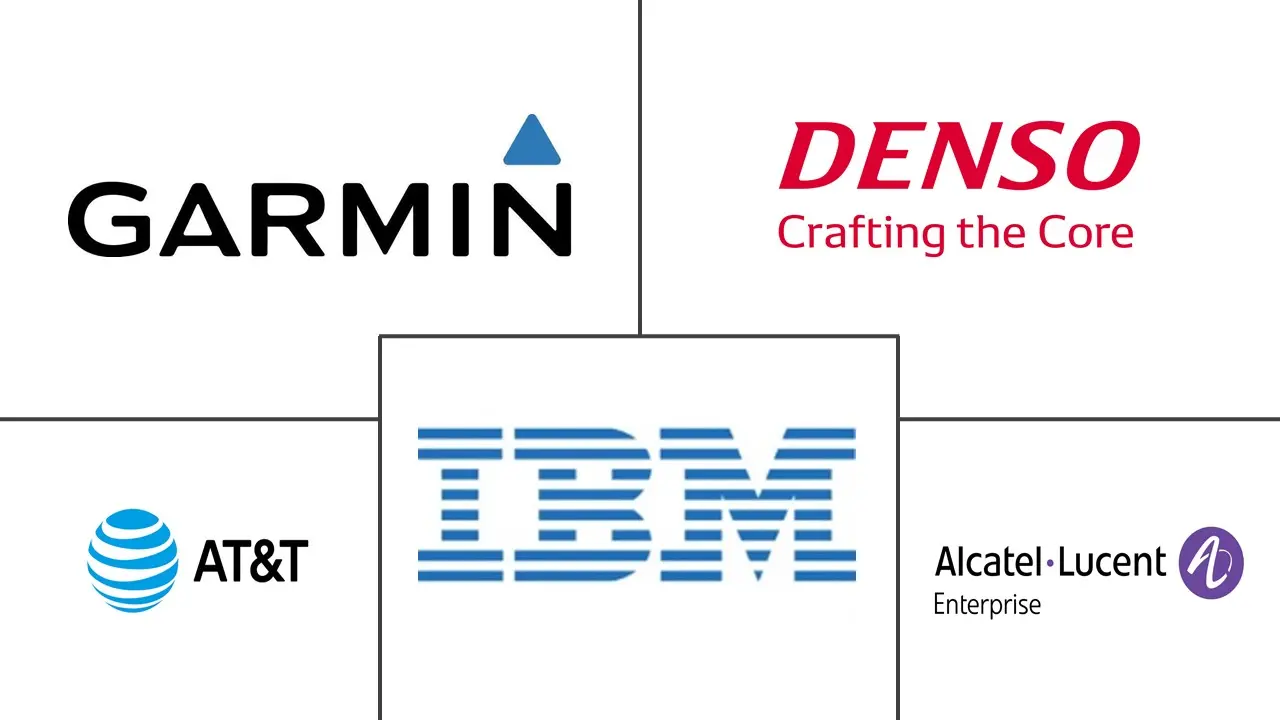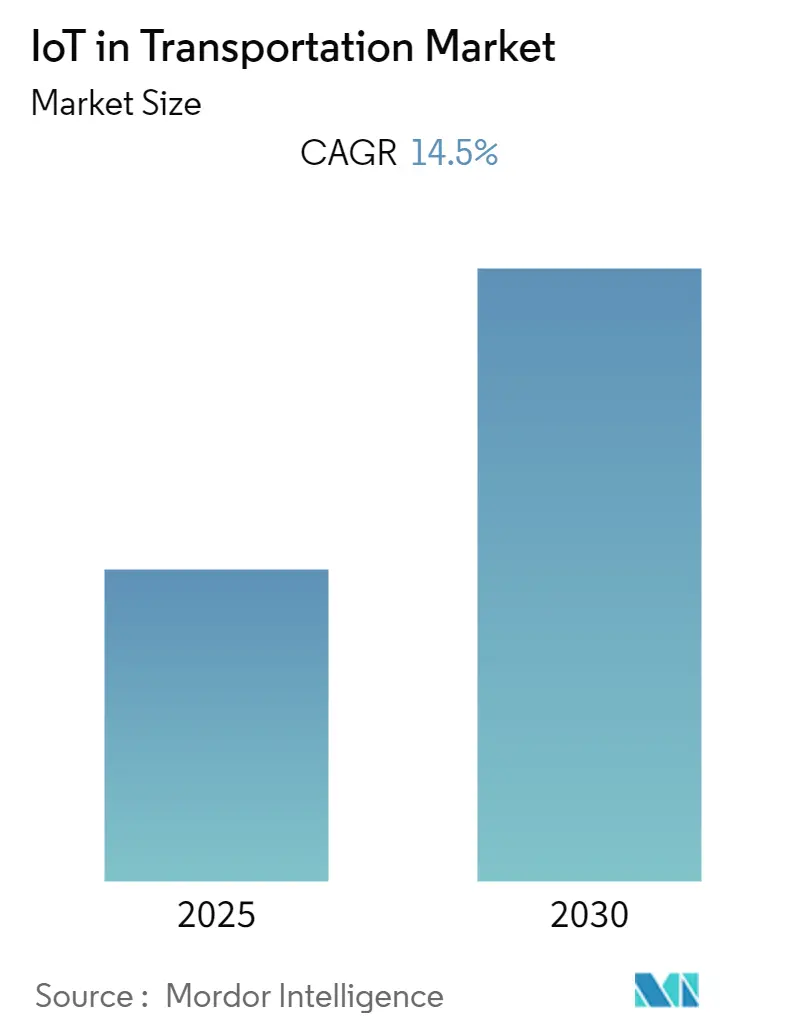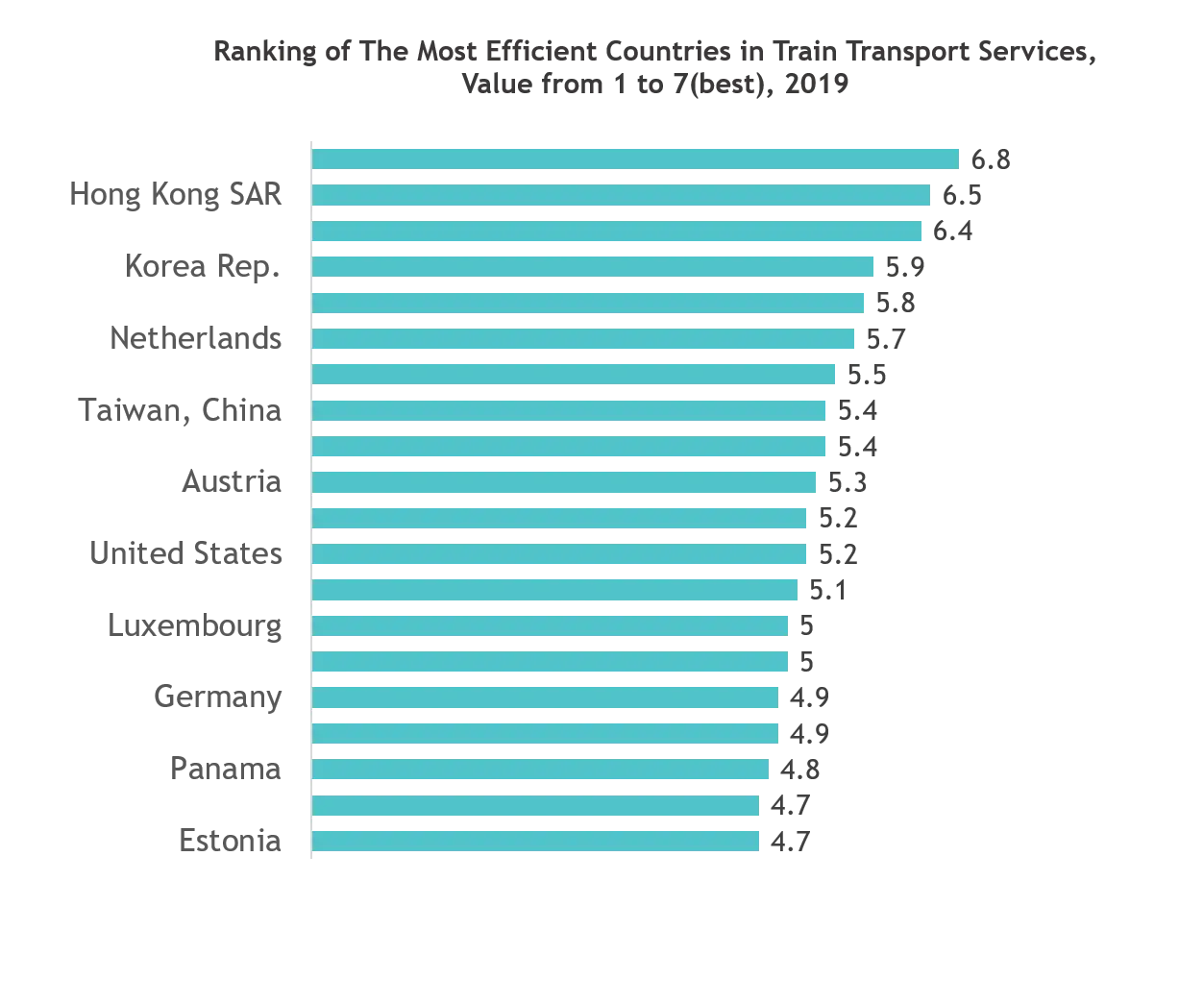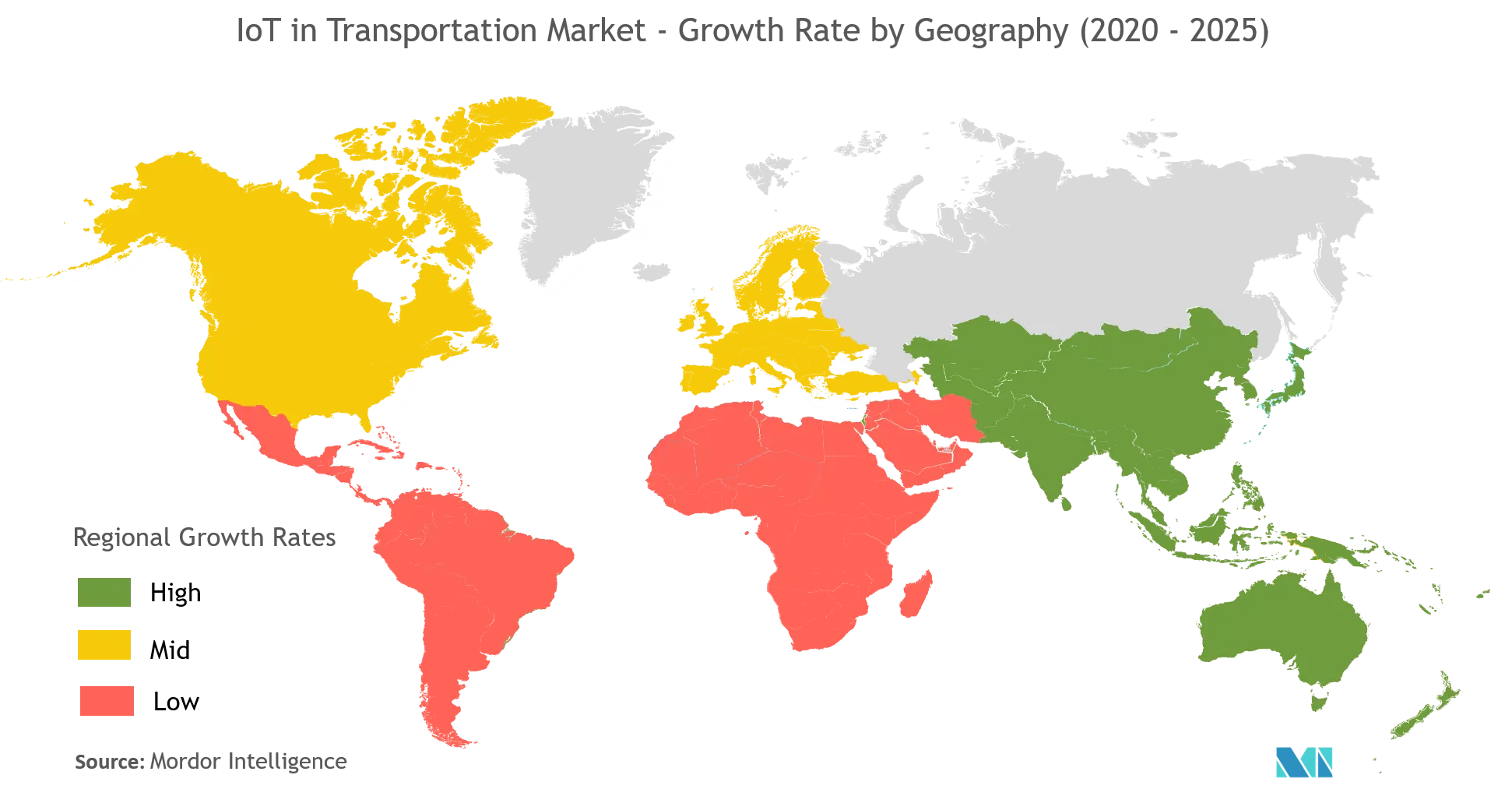IoT in Transportation Market Analysis
The IoT in Transportation Market is expected to register a CAGR of 14.5% during the forecast period.
- Global trends, such as digitization, connectivity, sustainability, energy conservation, and integration of IoT, have led to the advent of the smart railway system. The global population is expected to reach 9.8 billion by 2050, out of which 75% will dwell in cities. Hence, it has become imperative for public agencies to ensure that the transportation sector (specifically the rail network) is geared to meet the growing connectivity needs.
- For instance, considering the case of DHL, one of the largest logistics companies worldwide, in June 2019, the company partnered with ALPS Electric Europe GmbH, a prominent manufacturer of electromechanical devices, and Sigfox, a French-based IoT service provider, to optimize supply chain processes of DHL's German parcel network using asset tracking systems and advanced networked sensors.
- Due to the recent shut down of businesses across the world owing to the influence of Coronavirus is expected to influence the IoT in Transportation market negatively, as prices of chips, sensors and other components used in IoT devices may increase over time due to no production and exhaustion of stocks maintained by the manufacturers in few months on short term basis but in long term transportation and other industries might adopt automation on a large scale which will in turn provide opportunities to IoT.
IoT in Transportation Market Trends
The Railway Segment is Expected to Occupy Significant Market Share
- Time-table management, capacity optimization, timely travel service, and predictive maintenance are the primary reasons for the adoption of IoT solutions in railways systems. The rail network operators in developed parts of the world are actively investing in the development of analytics systems. Currently, cloud-based systems are prominent. For instance, Network Rail, UK, recently partnered with Deloitte to leverage the railway signaling systems to deliver 92.5% public performance measure (PPM).
- The growth of the railway system is expected to be primarily driven by the growing need for urban connectivity, and a higher emphasis on reducing emissions. By 2050, it is expected, that passenger mobility will increase by 200-300% and freight activity will increase by 150-250%, according to the International Transport Forum.
- The amount of data being generated by the rail network is driving the adoption of an IoT solution. According to leading railroad authority Lyndon Henry, over 1.5 million freight cars are handled by the U.S. railroads handle and monitor daily. This creates a huge amount of data over the cloud.
- However, there are many challenges to connectivity whilst on a train. The metal body of the train significantly weakens the network signal. Also, the use of multiple users reduces the capacity of the network, and tunnels block the signals. These are some of the technical limitations, restricting the deployment of IoT solution by the railway operators across the world.
North America to Hold a Significant Share in the Market
- The North America region is expected to dominate the IoT in the transportation market due to the strong presence of manufacturing and transportation and logistics industries with several technological advancements in the region. Also, government initiatives and regulations in various end-user industries are expected to proliferate the market growth in the region.
- For instance, the Federal Highway Association (FHWA), along with the American Association of State Highway and Transportation Officials (AASHTO), State and local departments of transportation (DOTs) have been encouraging the application of asset management in the transportation and logistics industry and hence promoting the application of IoT solutions in the transportation industry.
- International and domestic companies in the logistics industry of the United States have benefited from a highly skilled workforce and relatively low costs. according to the data from Select USA, United States Business Logistics Costs reached USD 1.6 trillion in 2018, which is 8% of GDP, indicating the high-level activity in the region.
- Moreover, the region has always been dominant in technology adoption in almost every end-user industry and has been one of the largest regions to implement IoT across industries. For instance, in March 2019, NimbeLink, a provider of cellular Internet of Things (IoT) solutions and services, started providing its NimbeLink AT2 Asset Tracking Solution in Canada, on the TELUS LTE-M network. Also, in February 2020, NimbeLink collaborated with Amazon Web services to launch LTE-M cellular-based asset tracking solutions.
IoT in Transportation Industry Overview
The IoT in the transportation market is highly fragmented, owing to the presence of various global and local industry players. The market players of the industry are viewing strategic partnerships and acquisition as a lucrative path towards expansion as it helps them to leverage the strengths and skills of the other companies in the market and enhance their market presence through strategic collaboration. Recent developments in the market are -
- January 2020 - Verizon announced that it has partnered with Audi America., to deliver advanced connectivity and embedded in-vehicle connectivity solutions. Reportedly, these solutions enable Audi's connected vehicle service (launching in 2020) are expected to be initially featured in Audi A4 and A5 model lines.
- November 2019 - AT&T announced a collaboration with Nokia to delivering Munich-based innovation studio to support the growing global adoption of current and next-generation Internet of Things (IoT) solutions. This partnership will enable AT&T to help solve business problems associated with IoT solutions such as asset tracking and help it capture the European ecosystem.
IoT in Transportation Market Leaders
-
Alcatel-Lucent
-
AT & T Inc.
-
Garmin International Inc.
-
IBM Corporation
-
Denso Corporation
- *Disclaimer: Major Players sorted in no particular order
IoT in Transportation Industry Segmentation
The Internet of Things (IoT) can change the transport industry by transforming how transportation systems gather and make use of data. IoT devices are deployed in traffic congestion control systems, in telematics systems within motor vehicles, in reservation and booking systems used by transport operators, in security and surveillance systems, and in remote vehicle monitoring systems to serve benefits such as enhanced traveler experience, increased safety, reduced energy use and congestion and better operational performance.
| Type | Hardware | ||
| Software | |||
| Services | |||
| Mode of Transport | Roadways | ||
| Railways | |||
| Airways | |||
| Maritime | |||
| Application | Traffic congestion control system | ||
| Automotive telematics | |||
| Reservation, toll, & ticketing systems | |||
| Security and surveillance system | |||
| Remote monitoring | |||
| Other Applications | |||
| Geography | North America | United States | |
| Canada | |||
| Europe | United Kingdom | ||
| Germany | |||
| France | |||
| Rest of Europe | |||
| Asia-Pacific | China | ||
| India | |||
| Japan | |||
| Rest of Asia-Pacific | |||
| Latin America | |||
| Middle East and Africa | |||
IoT in Transportation Market Research FAQs
What is the current IoT in Transportation Market size?
The IoT in Transportation Market is projected to register a CAGR of 14.5% during the forecast period (2025-2030)
Who are the key players in IoT in Transportation Market?
Alcatel-Lucent, AT & T Inc., Garmin International Inc., IBM Corporation and Denso Corporation are the major companies operating in the IoT in Transportation Market.
Which is the fastest growing region in IoT in Transportation Market?
Asia Pacific is estimated to grow at the highest CAGR over the forecast period (2025-2030).
Which region has the biggest share in IoT in Transportation Market?
In 2025, the North America accounts for the largest market share in IoT in Transportation Market.
What years does this IoT in Transportation Market cover?
The report covers the IoT in Transportation Market historical market size for years: 2019, 2020, 2021, 2022, 2023 and 2024. The report also forecasts the IoT in Transportation Market size for years: 2025, 2026, 2027, 2028, 2029 and 2030.
Our Best Selling Reports
IoT in Transportation Industry Report
Statistics for the 2025 IoT in Transportation market share, size and revenue growth rate, created by Mordor Intelligence™ Industry Reports. IoT in Transportation analysis includes a market forecast outlook for 2025 to 2030 and historical overview. Get a sample of this industry analysis as a free report PDF download.







